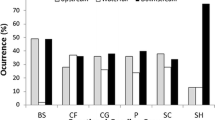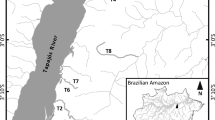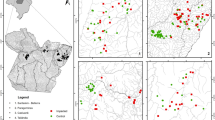Abstract
Initial colonists of empty habitats tend to differ from those arriving later in terms of species identity and traits. We evaluated the dynamics of the functional attributes in aquatic insect communities during a colonization experiment under natural conditions. We tested whether the late stages of colonization show higher functional richness, diversity and specialization than early successional stages. We used 60 artificial slate samplers that were removed after 1, 3, 5, 10, 15 and 30 days of colonization. We considered five traits (with a total of 17 trait categories): feeding habits, dispersal medium, body size, body shape and locomotion. With these traits, we computed a global specialization index at the community level. Large shredders with a cylindrical body shape and fly dispersal while flying were prominent in late colonization. In contrast, early colonists tended to have flattened body and to disperse through water. Functional diversity and functional richness significantly increased in late colonization, resulting in a more specialized community. Our results suggest that any interference during the processes involved in stream insect colonization can be reflected in the community through the decrease or even lack of functional attributes.
Similar content being viewed by others
References
Baer, S. G., E. R. Siler, S. Eggert & J. B. Wallace, 2001. Colonization and production of macroinvertebrates on artificial substrates: upstream–downstream responses to a leaf litter exclusion manipulation. Freshwater Biology 46: 347–365.
Baptista, D. F., D. F. Buss, L. G. Dias, J. L. Nessimian, E. R. Da Silva, A. H. A. MoraisNeto, S. N. Carvalho, M. A. Oliveira & L. R. Andrade, 2006. Functional feeding groups of Brazilian Ephemeroptera nymphs: ultrastructure mouthparts. Annales de Limnologie – International Journal of Limnology 42: 87–96.
Barsanti, L. & P. Gualtieri, 2006. Algae: Anatomy, Biochemistry, and Biotechnology. Taylor & Francis, Boca Raton.
Bellisario, B., C. Carere, F. Angeletti, D. Nascetti & R. Cimmaruta, 2013. Infaunal macrobenthic community dynamics in a manipulated hyperhaline ecosystem: a long-term study. Aquatic Biosystems 9: 20.
Biggs, B. J. F. & C. Kilroy, 2000. Stream Periphyton Monitoring Manual. Prepared for the New Zealand Ministry for the Environment. National Institute of Water and Atmospheric Research, Christchurch.
Botta-Dukát, Z., 2005. Rao’s quadratic entropy as a measure of functional diversity based on multiple traits. Journal of Vegetation Science 16: 533–540.
Boyero, L. & J. Bosch, 2004. Multiscale spatial variation of stone recolonization by macroinvertebrates in a Costa Rican stream. Journal of Tropical Ecology 20: 85–95.
Braccia, A., S. L. Eggert & N. King, 2014. Macroinvertebrate colonization dynamics on artificial substrates along an algal resource gradient. Hydrobiologia 727: 1–18.
Cardinale, B. J., C. M. Smith & M. A. Palmer, 2001. The influence of initial colonization by hydropsychid caddisfly larvae on the development of stream invertebrate assemblages. Hydrobiologia 455: 19–27.
Castro, D. M., S. Dolédec & M. Callisto, 2017. Landscape variables influence taxonomic and trait composition of insect assemblages in Neotropical savanna streams. Freshwater Biology 62: 1472–1486.
Chang, C.-Y. & D. J. Marshall, 2017. Quantifying the role of colonization history and biotic interactions in shaping communities: a community transplant approach. Oikos 126: 204–211.
Chevenet, F., S. Dolédec & D. Chessel, 1994. A fuzzy coding approach for the analysis of long-term ecological data. Freshwater Biology 31: 295–309.
Clavel, J., R. Julliard & V. Devictor, 2010. Worldwide decline of specialist species: toward a global functional homogenization. Frontiers in Ecology and the Environment 9: 222–228.
Cornwell, W. K., D. W. Schwilk & D. D. Ackerly, 2006. A trait-based test for habitat filtering: convex hull volume. Ecology 87: 1465–1471.
Cummins, K. W. & G. H. Lauf, 1969. The influence of substrate particle size on the microdistribution of stream macrobenthos. Hydrobiologia 34: 145–181.
Decian, V. S., E. M. Zanin, C. H. Oliveira & F. R. Quadros, 2010. Diagnóstico ambiental do COREDE norte, RS: mapeamento do uso da terra na região Alto Uruguai eobtenção de banco de dados relacional de fragmentos devegetação arbórea. Ciência e Natura 32: 119–135.
Devictor, V., R. Julliard, D. Couvet, A. Lee & F. Jiguet, 2007. Functional homogenization effect of urbanization on bird communities. Conservation Biology 21: 741–751.
Devictor, V., R. Julliard & F. Jiguet, 2008. Distribution of specialist and generalist species along spatial gradients of habitat disturbance and fragmentation. Oikos 117: 507–514.
Devictor, V., J. Clavel, R. Julliard, S. Lavergne, D. Mouillot, W. Thuiller, P. Venail, S. Villeger & N. Mouquet, 2010. Defining and measuring ecological specialization. Journal of Applied Ecology 47: 15–25.
Downes, B. J., P. S. Lake, E. S. G. Schreiber & A. Glaister, 1998. Habitat structure and regulation of local species diversity in a stony, upland stream. Ecological Monographs 68: 237–257.
Downes, B. J., P. S. Lake, E. S. G. Schreiber & A. Glaister, 2000. Habitat structure, key resources and diversity: the separate effects of surface roughness and macroalgae on stream invertebrates. Oecologia 123: 569–587.
Dray, S. & A. B. Dufour, 2007. The ade4 package: implementing the duality diagram for ecologists. Journal of Statistical Software 22: 1–20.
Fernández, H. R. & E. Domínguez, 2001. Guía para la determinación de los artrópodos bentónicos Sudamericano. Universidade de Tucumán, Tucumán.
Fisher, D. O. & I. P. F. Owens, 2004. The comparative method in conservation biology. Trends in Ecology and Evolution 19: 391–398.
Forister, M. L., L. A. Dyer, M. S. Singer, J. O. Stireman III & J. T. Lill, 2012. Revisiting the evolution of ecological specialization, with emphasis on insect–plant interactions. Ecology 93: 981–991.
Futuyma, D. & G. Moreno, 1988. The evolution of ecological specialization. Annual Review of Ecology and Systematics 19: 207–223.
Gayraud, S., B. Statzner, P. Bady, A. Haybachp, F. Schöll, P. Usseglio-Polatera & M. Bacchi, 2003. Invertebrate traits for the biomonitoring of large European rivers: an initial assessment of alternative metrics. Freshwater Biology 48: 2045–2064.
Gotelli, N. J. & R. K. Colwell, 2001. Quantifying biodiversity: procedures and pitfalls in the measurement and comparison of species richness. Ecology Letters 4: 379–391.
Graça, M. A. S., P. Pinto, R. Cortes, N. Coimbra, S. Oliveira, M. Morais, M. J. Carvalho & J. Malo, 2004. Factors affecting macro-invertebrate richness and diversity in Portuguese streams: a two-scale analysis. International Review of Hydrobiology 89: 151–164.
Hamada, N., J. L. Nessimian & R. B. Querino, 2004. Insetos aquáticos na Amazônia brasileira : taxonomia, biologia e ecologia. Editora do INPA, Manaus.
Heino, J., P. Louhi & T. Muotka, 2004. Identifying the scales of variability in stream macroinvertebrate abundance, functional composition and assemblage structure. Freshwater Biology 49: 1230–1239.
Hepp, L. U. & A. S. Melo, 2013. Dissimilarity of stream insect assemblages: effects of multiple scales and spatial distances. Hydrobiologia 703: 239–246.
Hepp, L. U., S. V. Milesi, C. Biasi & R. M. Restello, 2010. Effects of agricultural and urban impacts on macroinvertebrates assemblages in streams (Rio Grande do Sul, Brazil). Zoologia 27: 106–113.
Hepp, L. U., V. L. Landeiro & A. S. Melo, 2012. Experimental assessment of the effects of environmental factors and longitudinal position on alpha and beta diversities of aquatic insects in a neotropical stream. International Review of Hydrobiology 97: 157–167.
Holt, R. D., J. H. Lawton, G. A. Polis & N. D. Martinez, 1999. Trophic rank and the species–area relationship. Ecology 80: 1495–1504.
Hutchinson, G. E., 1957. Concluding remarks. Cold Spring Harbor Symposia on Quantitative Biology 22: 415–427.
Hubbell, S. P., 2001. The Unified Neutral Theory of Biodiversity and Biogeography. Monographs in Population Biology. Princeton University Press, Princeton.
Lammert, M. & J. D. Allan, 1999. Assessing biotic integrity of streams: effects of scale in measuring the influence of land use/cover and habitat structure on fish and macroinvertebrates. Environmental Management 23: 257–270.
Lecerf, A. & J. S. Richardson, 2010. Litter decomposition can detect effects of high and moderate levels of forest disturbance on stream condition. Forest Ecology and Management 259: 2433–2443.
Laliberté, E. & P. Legendre, 2010. A distance-based framework for measuring functional diversity from multiple traits. Ecology 91: 299–305.
Levins, R., 1968. Evolution in Changing Environments: Some Theoretical Explorations. Princeton University Press, Princeton.
Le Viol, I., F. Jiguet, L. Brotons, S. Herrando, A. Lindström, J. W. Pearce-Higgins, J. Reif, C. Van Turnhout & V. Devictor, 2012. More and more generalists: two decades of changes in the European avifauna. Biology Letters 8: 780–782.
MacArthur, R. H. & E. O. Wilson, 1967. The Theory of Island Biogeography. Princeton University Press, Princeton.
Mackay, R. J., 1992. Colonization by lotic macroinvertebrates: a review of processes and patterns. Canadian Journal of Fisheries and Aquatic Sciences 49: 617–628.
Melo, A. S., 2005. Effects of taxonomic and numeric resolution on the ability to detect ecological patterns at local scale using stream macroinvertebrates. Archives fur Hydrobiologie 164: 309–323.
Merritt, R. W. & K. W. Cummins, 1996. An introduction to the aquatic insects of North America. Kendall/Hunt Publishing Company, Dubuque.
Milesi, S. V. & A. S. Melo, 2014. Conditional effects of aquatic insects of small tributaries on mainstream assemblages: position within drainage network matters. Canadian Journal of Fisheries and Aquatic Sciences 71: 1–9.
Miyake, Y., T. Hiura, N. Kuhara & S. Nakano, 2003. Succession in a stream invertebrate community: a transition in species dominance through colonization. Ecological Research 18: 493–501.
Mondy, C. & P. Usseglio-Polatera, 2014. Using fuzzy-coded traits to elucidate the non random role of anthropogenic stress in the functional homogenisation of invertebrate assemblages. Freshwater Biology 59: 584–600.
Munday, P. L., G. P. Jones & M. J. Caley, 1997. Habitat specialization and the distribution and abundance of coral-dwelling gobies. Marine Ecology Progress Series 152: 227–239.
Olden, J. D., N. L. Poff, M. R. Douglas, M. E. Douglas & K. D. Fausch, 2004. Ecological and evolutionary consequences of biotic homogenization. Trends in Ecology and Evolution 19: 18–24.
Poff, N. L. & J. V. Ward, 1990. Physical habitat template of lotic systems: Recovery in the context of historical pattern of spatiotemporal heterogeneity. Environmental Management 14: 629–645.
Price, P. W., R. F. Denno, M. D. Eubanks, D. L. Finke & I. Kaplan, 2011. Insect ecology: behavior, populations and communities. Cambridge University Press, Cambridge.
Rader, R., 1997. A functional classification of the drift: traits that influence invertebrate availability to salmonids. Canadian Journal of Fisheries and Aquatic Sciences 54: 1211–1234.
Reynaga, M. C. & D. A. Santos, 2012. Rasgos biológicos de macroinvertebrados de ríos subtropicales: patrones de variación a lo largo de gradientes ambientales espaciotemporales. Ecologia Austral 2: 112–120.
Salles, F. F., E. R. Da Silva, M. D. Hubbard & J. E. Serrão, 2004. As espécies de Ephemeroptera (Insecta) registradas para o Brasil. Biota Neotropica 4: 1–34.
Schoener, T. W., 1974. Resource partitioning in ecological communities. Science 185: 27–39.
Simberloff, D. S., 1970. Taxonomic diversity of island biotas. Evolution 24: 23–47.
Simberloff, D. S. & E. O. Wilson, 1970. Experimental zoogeography of islands. A two-year record of colonization. Ecology 51: 934–937.
The R Development Core Team, 2018. R: a language and environment for statistical computing. R Foundation for Statistical Computing, Vienna. ISBN 3–900051 –07–0, URL http://www.R-project.org.
Tomanova, S. & P. Usseglio-Polatera, 2007. Patterns of benthic community traits in Neotropical streams: relationship to mesoscale spatial variability. Fundamental and Applied Limnology 170: 243–255.
Tonello, G., L. A. Naziloski, A. M. Tonin, R. M. Restello & L. U. Hepp, 2016. Effect of Phylloicus on leaf breakdown in a subtropical stream. Limnetica 35: 243–252.
Tonin, A. M., L. U. Hepp, R. M. Restello & J. F. Gonçalves, 2014. Understanding of colonization and breakdown of leaves by invertebrates in a tropical stream is enhanced by using biomass as well as count data. Hydrobiologia 740: 79–88.
Townsend, C. R. & A. G. Hildrew, 1994. Species traits in relation to a habitat templet for river systems. Freshwater Biology 31: 265–275.
Villéger, S., N. W. H. Mason & D. Mouillot, 2008. New multidimensional functional diversity indices for a multifaceted framework in functional ecology. Ecology 89: 2290–2301.
Wallace, J. B., M. R. Whiles, S. Eggert, T. F. Cuffney, G. L. Lugthart & K. Chung, 1995. Long-term dynamics of coarse particulate organic matter in three Appalachian mountain streams. Journal of the North American Benthological Society 14: 217–232.
Ward, J. V., 1975. Bottom fauna–substrate relationships in a northern Colorado trout stream: 1945 and 1974. Ecology 56: 1429–1434.
Williams, D. D., 1980. Some relationships between stream benthos and substrate heterogeneity. Limnology and Oceanography 25: 166–172.
Williams, D. & M. Smith, 1996. Colonization dynamics of river benthos in response to local changes in bed characteristics. Freshwater Biology 36: 237–248.
Acknowledgements
We wish to thank Luiz Ubiratan Hepp and Rafael Chaves Loureiro for their field assistance. SVM received a student scholarship from the Conselho Nacional de Desenvolvimento Científico e Tecnológico (CNPq) and from Coordenação de Aperfeiçoamento de Pessoal de Nível Superior (CAPES) PDSE scholarship. ASM received research fellowships from CNPq (Proc. Nos. 309412/2014-5 and 307587/2017-7). This article was edited for proper English language, grammar, punctuation, spelling and overall style by editors and the service provided by this company: https://www.proof-reading-service.com/en/.
Author information
Authors and Affiliations
Corresponding author
Additional information
Handling editor: Marcelo S. Moretti
Publisher's Note
Springer Nature remains neutral with regard to jurisdictional claims in published maps and institutional affiliations.
Electronic supplementary material
Below is the link to the electronic supplementary material.
Rights and permissions
About this article
Cite this article
Milesi, S.V., Melo, A.S. & Dolédec, S. Assessing community functional attributes during substrate colonization: a field experiment using stream insects. Hydrobiologia 838, 183–192 (2019). https://doi.org/10.1007/s10750-019-03988-2
Received:
Revised:
Accepted:
Published:
Issue Date:
DOI: https://doi.org/10.1007/s10750-019-03988-2







